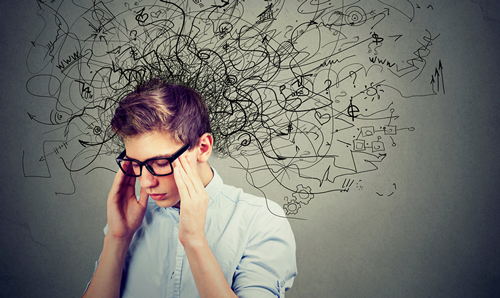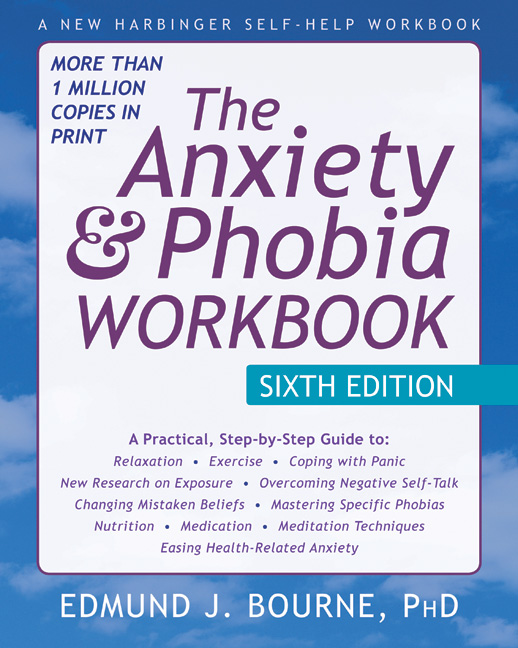An Interview with Anxiety Expert Edmund Bourne, PhD
In honor of Mental Health Awareness Month, we reached out to anxiety expert and self-help veteran Edmund Bourne—author of the bestselling classic, The Anxiety and Phobia Workbook. Now in its sixth edition and recommended by therapists worldwide, this landmark workbook has been the unparalleled, essential resource for people struggling with anxiety and phobias for almost thirty years. Here, Bourne offers valuable insight to help readers understand what causes anxiety, combat stigma and misinformation in the media, and move past the fearful “self-talk” that fuels fear, worry, and panic.
In the three decades since The Anxiety & Phobia Workbook was published, how have public perceptions of mental health challenges—and anxiety in particular—changed? Have they stayed the same?
Since 1990, the number of people willing to talk about someone they personally know with a mental health problem has doubled from about 30 to 60%. A larger proportion of the population recognizes that mental and behavioral problems are relatively common. So, in recent years, it has become more socially acceptable to talk about a friend or relative who has emotional difficulties.
In addition, the number of people admitting their own mental health difficulties has increased. In recent years 20 to 25% of people are willing to discuss emotional difficulties with others outside the context of their closest friends or relatives, whereas less than 15 percent would share about their problems thirty years ago. And finally, much like the decline in stigma, fewer people regard seeking out help for a mental health problem to be a “sign of weakness.”
Another major shift is that more people (up to 80%) deem mental health and physical health to be equally important. However, it is also apparent that a majority people perceive that more attention is given to physical illness than mental illness in our current health-care system. This is consistent with the fact that people who identify themselves as having emotional difficulties are less likely to seek out help than those with physical illnesses. Ethnic, racial, and socioeconomic factors predict how likely a person is to consult with a psychiatrist or psychologist versus trying to resolve their problems within their own family and broader community.
A final reason for lower utilization of mental health services is cost. Although the Affordable Care Act of 2010 increased the availability of mental health coverage, about 15% of adult Americans reported in 2015 that either they or household members had difficulty getting mental health care coverage.
What are some of the myths about anxiety and phobias that you would like to dispel?
A list of some of the most common myths about anxiety and phobias was compiled by the ADAA (Anxiety & Depression Association of America) in 2017. They include:
Having a phobia such as fear of seeing doctors or a fear of going far from home is an indication of being “crazy.”
The term “crazy” is a word often used carelessly to refer to any behavior or emotional challenge that doesn’t fall into the range of culturally normative behavior. One of the first things anxiety specialists need to do with clients is dispel any notions that they could go “crazy” or “insane.” Anxiety disorders in general simply don’t lead to the kinds of problems associated with psychotic conditions such a schizophrenia or bipolar disorder. In fact, there is an inverse relationship between having an anxiety disorder and having a psychotic disorder. Use of the term “crazy” to refer to an anxiety disorder is a false attribution.
A phobia is just an overrated fear.
When thought of as an overrated fear, someone might tell the phobic individual to “just get over it.” In truth, having a phobia can be a disabling problem that interferes with personal relationships and/or the ability to perform one’s job or go to school. The good news is that most phobias are readily treatable by a combination of exposure therapy and cognitive behavior therapy (CBT). However, a phobia is much more than an overrated fear.

If a panic attack gets too bad, you can pass out.
Panic attacks may cause very unpleasant sensations and feelings, but you won’t faint from one. During a panic attack, your heart is usually beating faster and harder, promoting increased blood flow to the brain, which is the opposite of what happens when fainting occurs (due to a slight decrease in cerebral blood flow).
If you feel anxious, it’s important to avoid stress or anxiety-producing situations.
A paradox about anxiety and phobias is that the more you try to avoid them, the worse they tend to get. Effective treatment of both panic attacks and phobias involves gradual exposure (i.e., incrementally facing) the very internal body sensations or external real-life situations your anxiety tries to persuade you to avoid.
The causes and roots of anxiety disorders are typically rooted in childhood.
Decades of research indicate that the most effective treatments for anxiety disorders deal with the here and now. The preferred treatment for anxiety disorders, CBT, teaches you strategies to manage fearful thoughts and emotions, as well as how to stop escaping internal sensations or outside situations you may have been avoiding in an effort to minimize fear.
Medications are the best treatment for anxiety disorders.
Research over decades has shown that while medication can be helpful, CBT is just as effective, and in some cases more effective than medication in treating anxiety. Many mental health practitioners use a combination of medication (such as an SSRI antidepressant) and CBT to most effectively treat anxiety disorders.
In our modern, fast-paced, and often troubling world, how do you know if you suffer from an anxiety disorder or if you’re simply worried about life/world events?
Anxiety is an inevitable part of life in contemporary society. It’s important to realize that there are many situations that come up in everyday life in which it is appropriate and reasonable to react with some anxiety or worry. If you didn’t feel any anxiety in response to everyday challenges involving potential loss or failure, something would be wrong.
Anxiety disorders are distinguished from everyday, normal anxiety in that they involve anxiety that is 1. more intense (for example, panic attacks), 2. lasts longer (anxiety that may persist for weeks or even months after a stressful situation has passed), or 3. leads to phobias that interfere with your life.
Criteria for diagnosing specific anxiety disorders have been established by the American Psychiatric Association and are described in a well-known diagnostic manual called the DSM-5 (Diagnostic and Statistical Manual of Mental Disorders—Fifth Edition).
If you’re concerned about whether you have a diagnosable anxiety disorder, you may consult chapter one of The Anxiety & Phobia Workbook, which provides detailed descriptions—as well as treatment recommendations—for each of the five major anxiety disorders: panic disorder, agoraphobia, social anxiety disorder, specific phobia, and generalized anxiety disorder, as well as two additional disorders that are generally though of as anxiety disorders through currently classified separately: obsessive-compulsive disorder and post-traumatic stress disorder.
What causes anxiety? Is it biological? Situational? Environmental?
Anxiety difficulties are brought about by a variety of causes operating on different levels: heredity, neurophysiology, family background and upbringing, conditioning, recent stressors, your self-talk (internal thought-processes) and belief systems, your ability to express your feelings and assert yourself, and numerous other factors.
There is no single cause of an anxiety disorder. Heredity and childhood circumstances play a predisposing role, but there also are many short-term, triggering causes that precipitate an anxiety disorder, such as a significant personal loss or trauma, a significant life change, or even use of stimulants and recreational drugs. Once you have acquired an anxiety disorder, there are many “maintaining causes” that can contribute to keeping it going, such as avoidance of anxiety provoking situations, anxious self-talk (fearful thoughts), mistaken beliefs, a high-stress lifestyle, personality traits such as perfectionism, poor nutrition, withheld feelings, or even a lack of meaning and sense of purpose in your life.
For a detailed discussion of the many causes of anxiety disorders, see chapter 2 of The Anxiety & Phobia Workbook. The remaining seventeen chapters of the book describe a wide range of strategies for overcoming each of the maintaining causes of anxiety disorders described above as well as several others.
How can we move past the stigma associated with anxiety and other mental health disorders so that more people seek the treatment they need?
Many people who live with mental illness are at some point blamed for their condition. They may be called names, told they are “going through a phase,” or, if they just “tried harder,” they could gain control over their problems.
Unfortunately, being blamed for something that is mostly out of one’s control promotes shame and guilt. In turn, shame can lead to discouragement about seeking treatment. If you feel ashamed of your condition, you may be less motivated to seek help for it.
The National Alliance on Mental Illness (NAMI), a grassroots organization the promotes education about mental health issues, offers a list of guidelines about reducing mental health stigma:
Some of the key guidelines include:
Education that mental health issues such as anxiety disorders or depression are genuine health problems that respond to professional help. For example, sharing books with significant others or friends that describe the nature, causes, and treatments for anxiety disorders, such as The Anxiety & Phobia Workbook, can assist with raising awareness that the problems are real.
1. Being conscious of language. Even a modicum of education leads to elimination of the use of adjectives that are entirely inappropriate, such as “weak,” “crazy,” “weird,” or even terms that borrow from names of conditions such as “obsessed” or “depressed.”
2. Encouraging equality between mental and physical illness. When people understand that mental health issues are significant problems—just as serious as physical illnesses—they can better appreciate what people with anxiety or mood disorders are going through as well as the need to seek out professional help. This also de-stigmatizes the use of prescription medications to treat mental health problems.
3. Self-empowerment. In brief, self-empowerment means owning your own life and refusing to allow others, who may not understand mental health issues, to dictate how you view or feel about yourself.
4. Compassion. Understanding the nature and challenge of mental health difficulties should promote more care, concern, and an increased sense of humanity toward those who struggle to overcome these types of problems.
5. Correcting broadcast and social media stigma. Though stigmatizing mental illness on TV has declined considerably in recent years, it’s important to call it out by contacting the broadcasting company or the program when it occurs. Stigmatizing posts or tweets on social media can be directly countered by posting/writing corrective educational material about mental health problems.
Why is cognitive behavioral therapy (CBT) so effective in treating anxiety disorders?
In head-to-head research comparisons between medication and therapy to treat anxiety disorders such as panic attacks, social anxiety, phobias, generalized anxiety, and obsessive-compulsive disorder, CBT has consistently proven to be equal or superior to medication. In some cases, the combination of CBT and medication has been shown to be very effective as well.
While there are many approaches for tackling anxiety disorders, CBT relies on a time-honored principle: what we say to ourselves mentally in response to any situation largely determines our mood and feelings about the situation.
The realization that what you think to yourself—your “self-talk”—is largely responsible for how you feel is empowering once you fully accept it. It is an important key to living a happier and more effective life.
People who suffer from anxiety are especially prone to suffer from fearful self-talk. Anxiety can be generated on the spur of the moment by internal mental thoughts (self-talk) that begin with the two words “what if.” The anxiety you experience in anticipation of a challenging situation arises largely from your own “what if” statements within your mind. When you decide to avoid a situation altogether out of fear, it’s likely because of scary questions you’ve asked yourself: “What if I panic?” “What if I can’t handle it?” “What will other people think of me if they see me anxious?” “What if I lose control or even go crazy?” These are a few among many so-called “catastrophic thoughts” that tend to generate panic, avoidance, or general anxiety.
CBT is a step-by-step process of learning to 1. identify, 2. challenge, and 3. replace catastrophic thoughts with more realistic and constructive thoughts. As mentioned, research over the past three decades has shown consistently that CBT can be effective in reducing fearful thinking that drives anxiety disorders. CBT can be practiced on your own or with the assistance of a trained therapist. The following example illustrates how the various steps of CBT work:
1. Identify the fearful, catastrophic thought: “I have low energy and feel tired a lot of the time—what if I have cancer and don’t know it?’
2. Question the validity of the fearful thoughts: What are the realistic odds that feeling low energy and fatigue actually mean I have cancer? There are obviously many reasons why I could have low energy, such as allergies, stress, or even a non-threatening medical condition such as anemia. In the unlikely instance that I had actually had cancer, how terrible could that be? Would I actually go to pieces and not be able to continue living?
3. Replace fearful thoughts with more constructive thoughts. Symptoms of fatigue and low energy can be indicative of all kinds of physical and psychological conditions, including a low-grade virus, anemia, hypothyroidism, depression, or food allergies, just to name a few. There are many possible explanations of my condition, and I don’t have specific symptoms that would suggest cancer. So, the odds of my low energy and fatigue being indicative of cancer are very, very low.
 Edmund Bourne, PhD, has specialized in the treatment of anxiety, phobias, and other stress-related disorders for over two decades. His self-help books have helped over a million people and have been translated into numerous languages. He currently resides in Florida and California.
Edmund Bourne, PhD, has specialized in the treatment of anxiety, phobias, and other stress-related disorders for over two decades. His self-help books have helped over a million people and have been translated into numerous languages. He currently resides in Florida and California.


 2024 Peace Playbook: 3 Tactics to Avoid Clashes with Your Partner
2024 Peace Playbook: 3 Tactics to Avoid Clashes with Your Partner